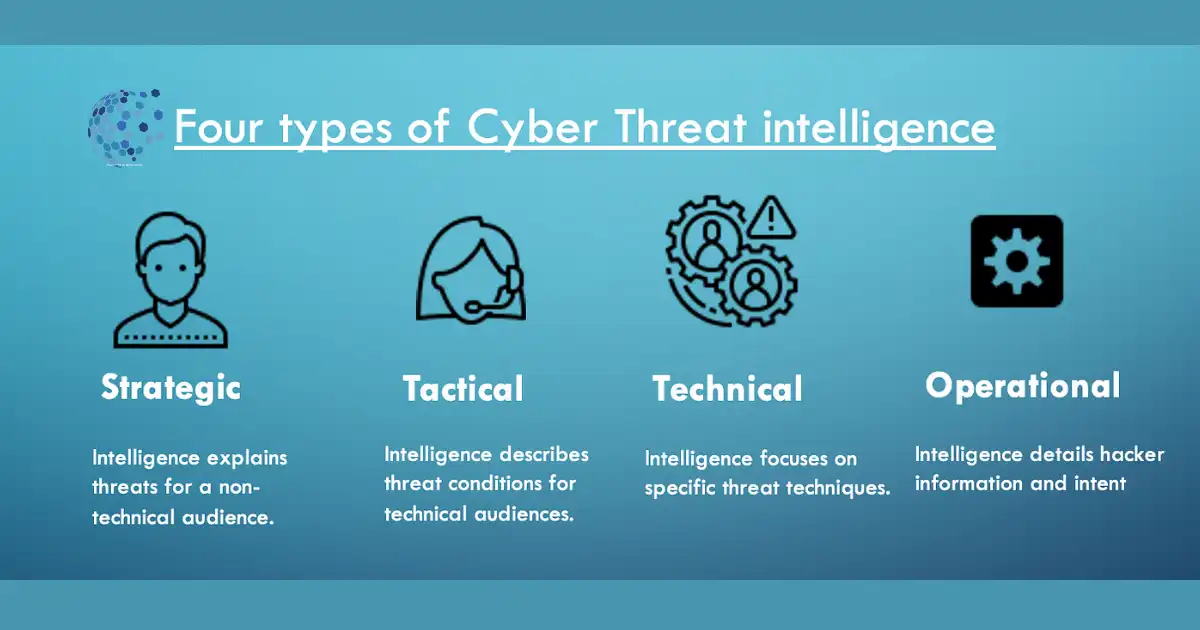The types of cyber threat intelligence are crucial for strengthening cybersecurity defenses, in today’s digital world. Cyber threat intelligence (CTI) equips organizations with vital insights to anticipate, prepare for, and respond to emerging threats. By analyzing adversaries, their tactics, and the ever-evolving risks, CTI helps protect sensitive information and critical systems.
This comprehensive guide will explore the four main types of cyber threat intelligence, strategic, tactical, operational, and technical, and how each contributes to a robust and well-rounded cybersecurity strategy.
Introduction to Cyber Threat Intelligence (CTI)
What is Cyber Threat Intelligence (CTI)?
Cyber Threat Intelligence (CTI) refers to the collection, analysis, and dissemination of information related to current and potential cyber threats. This intelligence empowers organizations to make informed decisions about their security measures by providing actionable insights into the tactics, motivations, and resources of threat actors. CTI goes beyond reactive security measures; it is proactive, enabling organizations to anticipate and counteract cyber risks before they materialize.
Importance of CTI in Cybersecurity
CTI plays an essential role in strengthening a company’s defenses against evolving cyber threats. By staying informed on adversarial tactics, organizations can bolster their detection and prevention capabilities, making it harder for attackers to succeed. It helps align security strategies with the latest threat landscape, providing organizations with a competitive advantage in cybersecurity.
The Four Types of Cyber Threat Intelligence
Cyber threat intelligence can be categorized into four main types, each serving a specific function:
- Strategic Threat Intelligence
- Tactical Threat Intelligence
- Operational Threat Intelligence
- Technical Threat Intelligence
Let’s explore each of these in detail.

Strategic Threat Intelligence
Overview of Strategic Threat Intelligence
Strategic threat intelligence focuses on high-level, long-term cybersecurity trends and risks that could affect an organization’s overall security posture. It provides a broad understanding of the motivations, objectives, and capabilities of threat actors, often in the context of global geopolitical events or major technological shifts.
Key Features
-
Focus on trends and patterns:
Rather than dealing with specific incidents, strategic threat intelligence examines long-term risks and how they may evolve.
-
Influence on decision-making:
This intelligence is primarily used by executives, CISOs, and other decision-makers to shape security policies and strategies.
-
Business impact:
It helps organizations align their cybersecurity efforts with business objectives, regulatory requirements, and future threats.
Why Strategic Intelligence is Important
Decision-makers need to allocate resources and develop long-term security strategies based on potential risks to the business. Strategic threat intelligence helps them:
-
Assess future risks:
By understanding how global trends (e.g., geopolitical tensions or technological advances) can affect their industry.
-
Prioritize investments:
Identifying key areas of vulnerability allows companies to invest in the right tools, technologies, and processes to mitigate risks.
-
Enhance resilience:
Focusing on the broader threat landscape enables organizations to be prepared for shifts that could impact operations or reputation.
Tactical Threat Intelligence
Overview of Tactical Threat Intelligence
Tactical threat intelligence provides detailed information on the tactics, techniques, and procedures (TTPs) that cybercriminals use in their attacks. This intelligence is vital for identifying the immediate threats facing an organization and assisting security teams in crafting effective countermeasures.
Key Features
-
Granular threat details:
Focuses on the “how” of cyberattacks, detailing the specific tools and methods used by threat actors.
-
Real-time application:
Tactical intelligence is used by security operations teams to strengthen defenses against specific attack types.
-
Indicators of Compromise (IoCs):
Security teams utilize IoCs, such as malware hashes, domain names, and IP addresses, to detect and block malicious activities.
Importance of Tactical Intelligence for Security Teams
Tactical intelligence is essential for day-to-day cybersecurity operations. It enables security professionals to:
-
Detect attacks early:
By recognizing the TTPs associated with known attackers.
-
Mitigate risks promptly:
When security teams are equipped with up-to-date intelligence, they can respond faster to emerging threats.
-
Improve incident response:
Tactical intelligence helps security teams focus their efforts on immediate dangers and minimize the impact of attacks.
Operational Threat Intelligence
Overview of Operational Threat Intelligence
Operational threat intelligence delivers real-time information about specific threats that are actively targeting an organization. It helps to detect ongoing attacks, understand the threat actors involved, and implement quick defenses.
Key Features
-
Focus on specific campaigns:
Operational intelligence is often tied to a particular attack or group of attackers.
-
Real-time actionability:
This intelligence helps security teams take immediate action to mitigate threats, such as deploying patches or blocking malicious IP addresses.
-
Contextual information:
Provides detailed insights about the adversaries, their objectives, and the potential impact of their actions.
Role in Identifying Ongoing Threats
Operational intelligence allows organizations to:
-
Understand active threats:
Security teams can track adversary activities and adjust their defenses accordingly.
-
Respond to specific campaigns:
Quick insights into ongoing attacks enable timely responses, preventing further escalation.
-
Minimize damage:
By understanding the threat actor’s objectives, teams can prioritize actions to protect critical assets.
Technical Threat Intelligence
Overview of Technical Threat Intelligence
Technical threat intelligence deals with the nuts and bolts of cybersecurity, offering detailed technical information on cyber threats. This intelligence is used by cybersecurity tools and teams to identify specific indicators that suggest the presence of malicious activity.
Key Features
-
Focus on technical indicators:
This includes IP addresses, malware signatures, URLs, and file hashes.
-
Automated response:
Technical threat intelligence is often integrated into security platforms like firewalls, intrusion detection systems, and endpoint protection software.
-
Prevention of immediate threats:
By leveraging this intelligence, cybersecurity systems can automatically block known malicious entities.
Importance of Technical Intelligence
Technical intelligence is critical for:
-
Immediate threat blocking:
Automated systems use this intelligence to prevent attacks in real time.
-
Incident investigation:
It provides the necessary data for forensic teams to investigate breaches and identify the entry points of attackers.
-
Streamlining security operations:
With automated defenses, organizations can reduce manual intervention, allowing security teams to focus on more complex threats.
Comparison of Cyber Threat Intelligence Types
Here is the comparison between four CTI Types:
Strategic Threat Intelligence
-
Focus:
Long-term trends and risks
-
Primary Users:
Executives, CISOs
-
Impact:
Guides long-term strategy and resource planning
Tactical Threat Intelligence
-
Focus:
Tactics, techniques, and procedures (TTPs)
-
Primary Users:
Security operations teams
-
Impact:
Enhances defense against specific attack types
Operational Threat Intelligence
-
Focus:
Real-time information on specific threats
-
Primary Users:
Incident response teams
-
Impact:
Helps mitigate ongoing attacks
Technical Threat Intelligence
-
Focus:
Specific indicators of compromise (IoCs)
-
Primary Users:
Automated systems, Security Operations Center (SOC) teams
-
Impact:
Blocks immediate threats and supports forensic investigations
Use Cases of Cyber Threat Intelligence
Strategic Threat Intelligence:
A financial institution might use strategic intelligence to prepare for potential threats from nation-state actors targeting the banking sector.
Tactical Threat Intelligence:
A retail company’s security team could use tactical intelligence to identify phishing campaigns targeting their employees by recognizing familiar TTPs.
Operational Threat Intelligence:
An enterprise might use operational intelligence to thwart a ransomware attack by identifying the specific group behind the attack and adjusting defenses accordingly.
Technical Threat Intelligence:
An organization’s firewall might block malicious IP addresses associated with known botnets, using technical threat intelligence to prevent a Distributed Denial-of-Service (DDoS) attack.
You Might Be Interested In
- How Machine Learning Can Fight Cyber Attacks?
- What are solutions for cyber security?
- What are the 10 most common types of cyber attacks?
- What are the benefits of AI in cybersecurity?
- What is SIEM and how does it work?
Conclusion
Understanding the four types of cyber threat intelligence—strategic, tactical, operational, and technical—is essential for building a comprehensive cybersecurity strategy. Each type offers unique insights and serves different functions, from guiding long-term decisions to responding to immediate threats. By leveraging all four forms of intelligence, organizations can not only anticipate and prevent cyberattacks but also reduce their overall risk exposure, staying one step ahead of cybercriminals.
FAQ’s about “What are four types of cyber threat intelligence?”
What are the top 5 cybersecurity threats?
Here are the top 5 cybersecurity threats:
- Phishing: Fraudulent emails or messages that trick users into revealing sensitive information.
- Ransomware: Malware that encrypts data and demands a ransom for its release.
- Malware: Software designed to damage or disrupt systems, including viruses, trojans, and spyware.
- Insider Threats: Employees or contractors misusing access to harm or steal data.
- Distributed Denial-of-Service (DDoS) Attacks: Overwhelming systems with traffic to make them unavailable.
These threats pose significant risks to both individuals and organizations.
What is the most common type of cyber threat?
The most common type of cyber threat is phishing. Phishing attacks involve tricking individuals into revealing sensitive information, such as login credentials or financial data, through deceptive emails, messages, or websites that appear legitimate. This method is widely used because it preys on human error and is relatively easy for attackers to execute.
What are the 5 areas of cybersecurity?
The 5 key areas of cybersecurity are:
- Network Security: Protecting the integrity and accessibility of a network and its data by securing infrastructure from unauthorized access, misuse, or attacks.
- Information Security: Safeguarding data from unauthorized access, disclosure, modification, and destruction, ensuring confidentiality, integrity, and availability.
- Application Security: Securing software and applications by identifying and addressing vulnerabilities during development and throughout their lifecycle.
- Cloud Security: Protecting data, applications, and services in cloud environments by using policies, technologies, and controls tailored for cloud infrastructure.
- Identity and Access Management (IAM): Managing and controlling user access to systems, ensuring that only authorized users can access specific resources.
What are the 4 P’s of cyber security?
The 4 P’s of cybersecurity are:
- Protection: Implementing security measures, tools, and protocols to safeguard systems, data, and networks from cyber threats.
- Policies: Establishing guidelines and rules for managing cybersecurity practices, including data handling, access control, and incident response.
- Procedures: Defining detailed processes for handling security tasks, such as patch management, data backups, and security audits.
- People: Ensuring employees are trained in cybersecurity awareness and best practices, as human error is often the weakest link in security.
These four areas work together to build a strong cybersecurity framework.
What are the four key cyber functions?
The four key cyber functions are:
- Identify: Understanding and managing cybersecurity risks to systems, assets, data, and capabilities. This includes asset management, risk assessment, and governance.
- Protect: Implementing safeguards to ensure delivery of critical services, which involves access control, awareness training, data security, and protective technologies.
- Detect: Developing and implementing appropriate activities to identify the occurrence of a cybersecurity event. This includes continuous monitoring, detection processes, and anomaly detection.
- Respond: Taking action regarding a detected cybersecurity incident. This function involves response planning, incident response, and communication with stakeholders.
- Recover: (Sometimes considered the fifth function) Focuses on restoring services and capabilities after a cybersecurity incident, including recovery planning and improvements based on lessons learned.
These functions form the core of a robust cybersecurity strategy, helping organizations effectively manage their cybersecurity risks.

